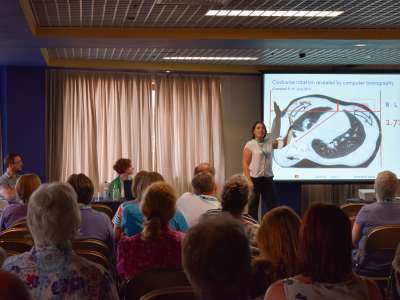
I came to the UK last year from Australia and have been working for different teams in London for the past 11 months: in the NHS wheelchair service and in the adult community occupational therapy team within the local authority.
I love learning something at a conference that I can apply immediately to my work. A presentation that particularly struck me at the Posture & Mobility Group (PMG) Conference 2017 in Cardiff was A person-centred approach to the protection and restoration of body shape: how can equipment in sitting and lying help meet individual goals and changing needs to improve quality of life, by Helena Poulton (occupational therapist) and Tess Ellis (physiotherapist).
Their presentations put forward that:
- Body shape changes, such as pelvic rotation and distortion of the chest, can be predicted for people with movement difficulties. Gravity exerts a continuous force on everybody. Longer time spent in static positions increases the likelihood of body shape changes, due to the constant force of gravity on the body (Hill & Goldsmith, 2010).
- When body shape changes affect the rib cage, it can cause respiratory difficulties. This may contribute to premature death for people with learning disabilities (Heslop, et al., 2013).
- Postural care should include support for lying and sitting positions, as these are the positions used during the day by those most at risk.
- Supporting people to sustain symmetrical positions is best for function and health.
We need to work towards symmetry within our clients' physical limits and within our clients' comfort and preference (Hill & Goldsmith, 2010). - Supine is the only truly symmetrical posture for lying in a bed (Hill & Goldsmith, 2010). [If the client can’t tolerate sleeping supine, work towards minimising rotation and reducing stretch on hip ligaments in side lying].
- Posture management equipment needs to be flexible and sustainable.
Consideration should be given to off-the-shelf products that can be adapted (e.g. modular backrest systems) before custom moulded foam options, especially for clients who fluctuate in their condition, or who are likely to change.
I had assumed that adult body shape was relatively fixed, or a deteriorating condition that we could only slow down. In one case study, a woman showed improvement in body shape after several years of using a posture management system in bed. She had been measured recently using the Goldsmith indices of body symmetry 8 months apart, and showed an improvement in her ribcage shape and in her wind sweeping index. Whilst the positioning equipment at night can be adjusted as her body shape changes, she needed a flexible adaptable seating solution which would change as her body shape continues to improve. The presenters were working with the local wheelchair service to achieve this.
I returned to my workplaces enthused about restoring body shape for the many clients seen in our services with asymmetrical postures due to neurological disabilities. Two clients immediately came to mind that I believed could live longer from postural support in lying. Both have respiratory problems. I went ahead and arranged a visit with a supplier, as I assumed that something so essential would naturally be funded. Discussing the cases with my seniors, however, I realised it’s not that simple.
When I worked in Queensland, Australia, postural sleep systems were funded the same way as wheelchairs and bathing equipment, by the Department of Health. In the London borough where I work now, sleep positioning systems for adults have historically been funded only through charitable organisations.
Healthy body shape is fundamental for good breathing, circulation and digestion (Hill & Goldsmith, 2010). When people breath properly, they can do more and are less likely to require hospital admissions. How much does the cost of one sleep positioning system compare to the cost of a hospital admission for pneumonia, or new wheelchair and complex seating system every few years due to progression of body shape deformity? Prevention is better than cure.
This new knowledge has motivated me to advocate for provision of postural management systems. I’m not the first therapist to try this, nor the most qualified, but it’s important that we keep saying it. Thank you, PMG, for awakening me to the power 24-hour postural care has to improve quality of life and longevity. I have learnt valuable assessment skills and improved techniques for therapeutic positioning.
I’m excited to be a member of such a fantastic organisation and I look forward to watching the conference presentations again online.
References
Ellis, T. & Poulton, H., 2017. A person-centred apporach to the protection and restoration of body shape: how can equipment in sitting and lying help meet individual goals and changing needs to improve quality of life?. Cardiff, Posture and Mobility Group.
Heslop, P. et al., 2013. Confidential Inquiry into Premature Deaths of People with Learning Disabilities, Bristol: Norah Fry Research Centre.
Hill, S. & Goldsmith, J., 2010. Biomechanics and Body Shape Distrotion. Tizard Learning Disability Review, 15(2), pp. 15-32.






.jpg)



no comments
Add your comment...